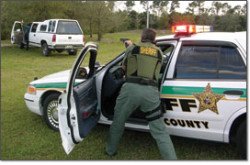The Ten Deadly Errors were part of the police academy I attended in the mid-90’s. The Errors were mentioned at the start of a officer survival training block, but they were not emphasized. I didn’t think much of it at the time, as I had been involved in armed security for several years prior to that and had read books like Street Survival on my own. The Errors were already part of my thinking.

Photo by PBSO
I recently was talking to some new officers, and on a whim, I inquired about their knowledge of the Ten Deadly Errors. I was a bit stunned to learn that they didn’t really know what I was talking about. Some of the information they knew, but the information wasn’t ingrained into them.
Detective Pierce R. Brooks, a Los Angeles PD homicide detective, wrote a book called “…officer down, code 3” way back in 1975. While I can’t say that this book was the start of the officer survival movement, it was certainly a key player. Brooks listed the Ten Deadly Errors that he identified as being the most common, repeated reasons for officers being killed in the line of duty. Brooks, some of you may recognize, was an investigating detective in the infamous Onion Field killings.
So, as a refresher to the vets, and as a learning experience for the new guys here are the Ten Deadly Errors:
1. Failure to Maintain Equipment and Proficiency – Clean your guns, magazines, and handcuffs. Keep your flashlights charged. Keep a fresh battery in your radio. Get to the range and practice shooting. Work with your zone partner on handcuffing techniques.
2. Improper Search, Improper Use of Handcuffs – A lot of cops have been hurt or killed because of a poor search. Learn how to do a systematic and thorough search of prisoners and frisks of suspicious people. Understand that weapons can be secreted anywhere on and in the body. When handcuffing, make sure they are on properly and double locked. Always handcuff behind the back. Here in Florida, we lost three law enforcement officers after a murder suspect was handcuffed in front and retrieved a handcuff key hidden on his person.
3. Sleepy or Asleep – If you do not get enough sleep, you become a danger to yourself and your partners. A lack of alertness is exceptionally dangerous.
4. Relaxing Too Soon – Do not relax until the call is over and you have left the jail and gone back in service. Most veteran officers can tell stories about a guy that was “cool” and then suddenly snapped. Offenders may act relaxed, but do not let them lull you into a false sense of security. If you slack off while around someone who wants to hurt you, you invite disaster.
5. Missing Danger Signs – Danger signs could be verbal cues, non-verbal cues, bulges, clothing, location, or any number of other things. A suspect who keeps touching his hip while talking to you could be giving you a non-verbal indication that he is armed. A suspect who doesn’t directly answer a question could be hiding information. A specific type, style, or color of clothing could be an indication of gang affiliation. Become informed of what danger signs may exist and then actively look for them.
6. Bad Positioning – Know where you are and figure out the safest place to be. For example, if you can get the cars in a traffic accident into a parking lot, wouldn’t that be a safer place than standing in the road to conduct your investigation? In a Terry Stop, how close are you to the suspect? Where is your cover officer? Can you effective respond to a sudden attack from your current position? Is there some form of cover you might be able to use?
7. Failure to Watch the Hands – Their eyes may be the windows to their soul, but their hands will kill you. Although watching the hands falls in with missing the danger signs, this error has hurt or killed so many officers, it is deserving of its own place on the list. Humans are tool users. With little exception, this means offenders will use their hands to obtain a weapon to attack you. Hands will retrieve a gun from the waistband, a knife from the pocket, or a baseball bat from behind the door. Can you see their hands? Where are the hands? What are they doing?
8. Tombstone Courage – Don’t rush in if you don’t need to. Take your time and wait for backup. Sometimes you have to go in alone. Most of the time you don’t, so wait for your partner!
9. Preoccupation – If you are messing with your computer or cell phone, how can you watch their hands or pick up on other danger signs? Also, if you are so stressed about your finances, relationship with your spouse, or about your drinking problem, how are you supposed to remain alert all shift? If you are stressed out, talk to a peer counselor or request help from the employee assistance program at your agency. There is no shame in asking for help, especially if it can prevent you getting hurt on the job.
10. Apathy – Don’t think it can happen to you? Think again. Bad things happen on all sorts of calls, on all shifts, and to officers of all levels of experience.
Stay Safe!
Kirk Rains says
Always a great reminder. I started in law enforcement back in 1977. Came across Brooks’ book in 1979, purchased it, and it has been my foundation since – 40+ years later. The basics never change, violating them always gets you in a jam. Learn, practice, & live.
Sean Perry says
Number 11 lack of exercise